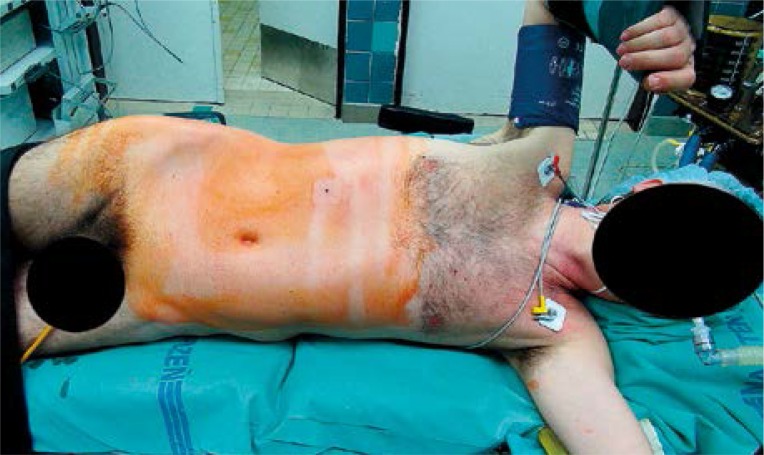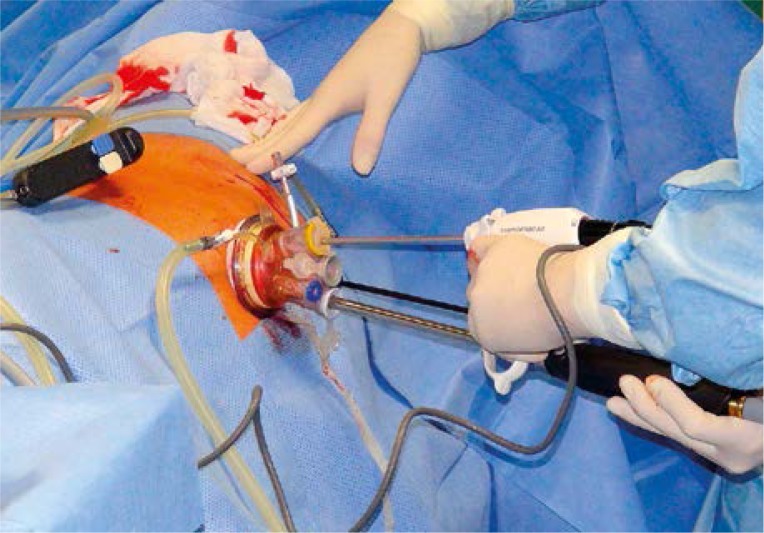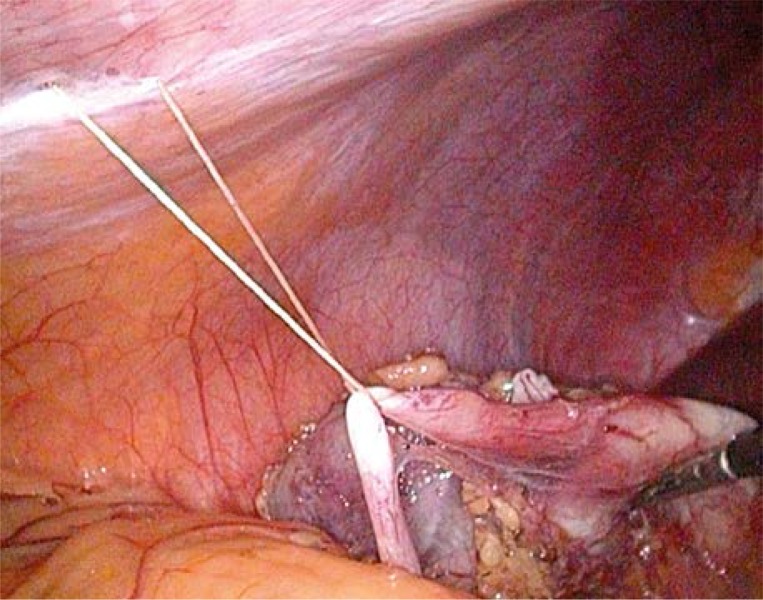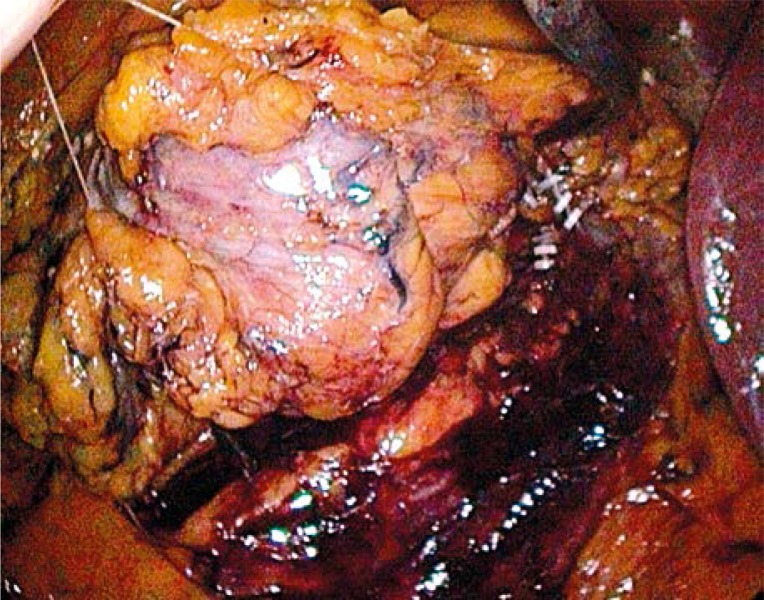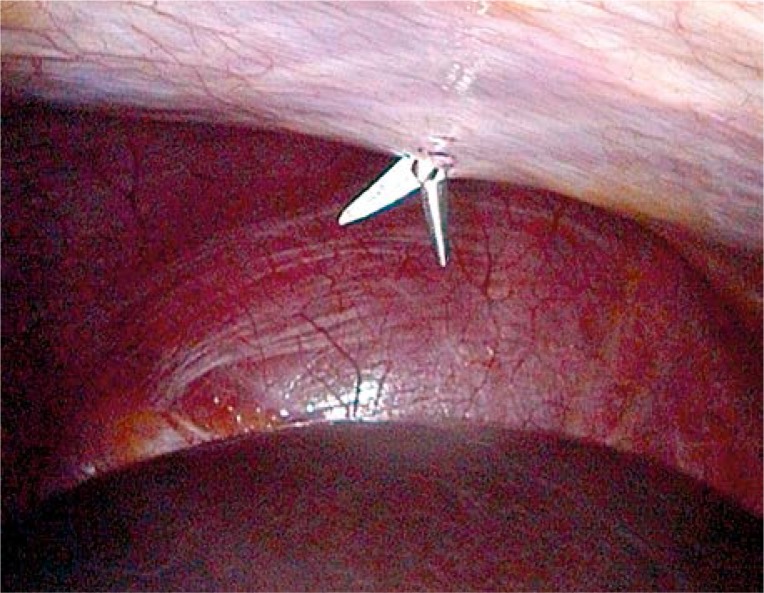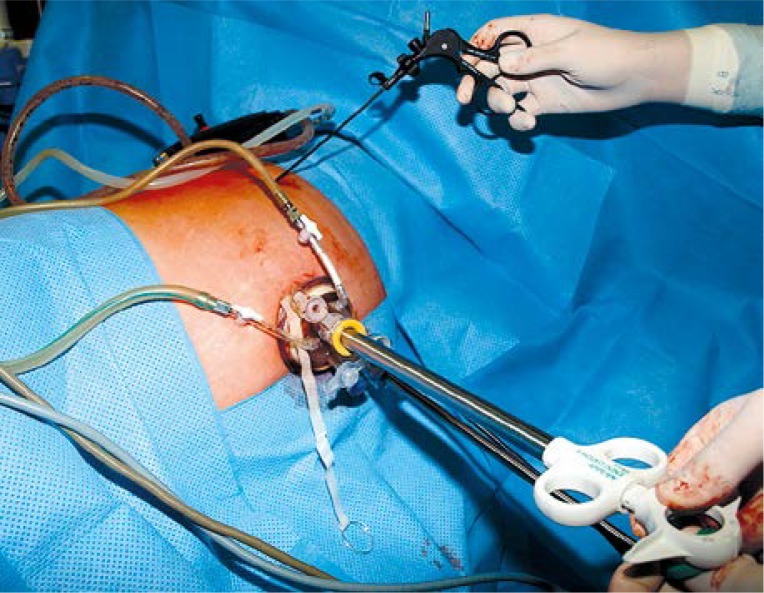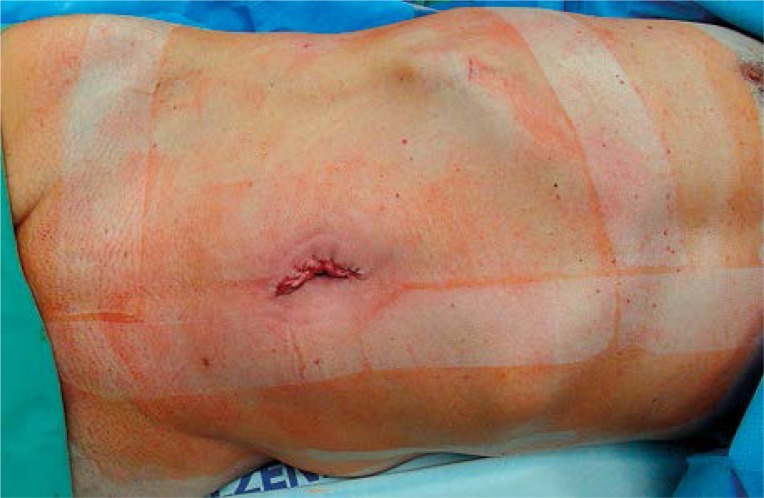Abstract
Introduction
One way how to reduce morbidity and improve cosmesic of kidney surgery is single site laparoscopy. Relatively well described concept but without defined position in clincal practise.
Aim
To report of institutional experience with laparoendoscopic single-site surgery (LESS) nephrectomy (NE) and compare (matched case-control study) it with that of standard laparoscopic NE (LNE).
Material and methods
In the period 8/2011 to 10/2013, we performed 183 mini-invasive NE (132 tumours, 51 benign aetiology); 45 of them (24.6%) were LESS, the rest LNE. The main but not absolute indications for LESS were: non-obese men, and less advanced tumours. In 13 patients undergoing LESS-NEs (28.9%) there was a transumbilical approach. For the rest, a pararectal incision was performed and an accessory port was added in 31.1% (14) – 2/22 (9.1%) left sided, 12/23 (52.2%) right sided. Twenty-four LESS-NE were performed by a more experienced surgeon (mean operation time (MOT) 73.1 min), 21 LESS-NE by 4 other surgeons (MOT 132.8 min). These 24 were compared with 43 LNE done by the same surgeon before the period of LESS (1/2007–8/2011) and with similar characteristics of cases (body mass index (BMI) ≤ 35 kg/m2, less advanced tumour).
Results
We found no statistically significant differences in any of the parameters studied. The MOT 73.1 min vs. 75.0 min (p = 0.78), BMI 27.4 kg/m2 vs. 29.2 kg/m2 (p = 0.08), blood loss 54.7 vs. 39.2 (p = 0.47). Complications (4.2% vs. 11.6%) were only of internal character in origin. No conversion in either group. In LESS-NE, staplers were used more frequently (more expensive than clips) for division of renal hilar vessels (70.8% vs. 51.2%). The mean price of LESS-NE was €367 higher.
Conclusions
The LESS NE performed by an experienced surgeon is a safe and efficient method for the surgical treatment of both malignant and benign renal conditions in patients with BMI < 30 kg/m2 and with low-stage tumours. The LESS NE is more expensive compared to LNE.
Keywords: kidney tumour, nephrectomy, laparoscopy, laparoendoscopic single-site surgery
Introduction
Laparoscopic nephrectomy (LNE) is a commonly employed method for the surgical treatment of both benign and malignant renal diseases [1–3]. In order to minimize the surgical trauma a minilaparoscopic approach, using instruments 2–3 mm in size, single port laparoscopy – laparo-endoscopic single-site surgery (LESS) and natural orifice transluminal endoscopic surgery (NOTES) – is useful. From a purely cosmetic point of view, laparoscopy with hidden incisions can be performed [4, 5]. However, minilaparoscopy does not change the concept of standard laparoscopy. The main difference is that some ports are replaced by 2–3 mm instruments. The main topic for progress in contemporary miniinvasive laparoscopic surgery is single port laparoscopy (surgery) – LESS. Various acronyms have been designated for this approach/technique [5, 6]. The urologic NOTES Working Group suggested as a consensus nomenclature the acronym LESS, as a general term for all new surgical procedures using one skin incision for access of camera and instruments, with or without an additional port of maximum 5 mm [6]. With one additional port, the term hybrid LESS may be used [7]. Nephrectomy (NE) seems to be the most important LESS surgery for clinical practice in urology, even in children [8]. The concept of LESS may also be applied to other urological, surgical and gynaecological procedures [2, 5, 9–12]. The LESS-NE is indicated mainly in selected cases (young, non-obese, non-neoplastic conditions (but if so, low-stage disease)) and this technique can replace about 50% of LNE [13]. Some authors however have applied LESS in more complicated situations such as larger tumours and previous abdominal surgery [14, 15]. Oncological results are comparable with LNE [3].
Aim
In this paper, we have, based on our experience, assessed the possible role of LESS-NE in everyday clinical practice as compared to standard (conventional) LNE.
Material and methods
We started performing LESS NE in 8/2011. Until 10/2013, we performed 183 miniinvasive laparoscopic NE including LESS nephrectomies (132 for malignant neoplasms and 51 for non-neoplastic aetiology). The LESS technique was used in 24.6% (n = 45) of them (33 for neoplasms and 12 for non-neoplastic aetiology). Thirteen (28.9%) were by transumbilical approaches, the rest pararectal incision. The LESS-NE constituted in 2011 (9–12) 20.7% of all miniinvasive NE (6/29), in 2012 19.8% (16/81) and in 1–10/2013 31.5% (23/73).
Patient selection
Patients indicated for LESS-NE were subselected from those indicated for LNE. The decision on what procedure to perform did not follow any standardized approach. The main but not strict indications were: non-obese, and less advanced tumours. And a surgeon able to perform the LESS technique was available at the time of the operation. The LESS was performed by five genito-urinary surgeons with varying experience of laparoscopic surgery. Two additional genito-urinary surgeons performed only standard LNE.
Operative technique
We have adopted the technique described by the Stolzenburg group [2, 16]. The patient is under general anaesthesia with a urethral catheter and he/she is placed in a lateral decubitus position with a slight table break at the waist (Photo 1). Through about 4 cm small peri-umbilical (only slim patient and more skilled surgeon) or pararectal incision a multi-channel single port Quadport+® Olympus is inserted (Photo 2). We employ a standard rigid straight full HD laparoscopic camera 10 mm 0° and only two 5 mm working instruments at the same moment. One pre-bent grasper (during the whole operation) and one standard straight instrument – mainly any sealing device (harmonic scalpel of different brands, Ligasure 35 mm Blunt Tip®, Thunderbeat® or EnSeal®) – are used (see Table I). The straight instrument is replaced sometimes with suction, hook with electrocautery, clip applicator, bipolar forceps, scissors or stapler. Dorsal peritoneum is incised laterally to the colon. Gerota's fascia is opened longitudinally and medially to the kidney. The ureter is liberated and elevated with thread with a straight needle inserted through the lateral part of the abdominal wall (Photos 3, 4). The area of hilar vessels is visualised by this manoeuvre. In some cases with the need to elevate the liver or spleen, a 3 mm grasper is inserted directly through the abdominal wall (without the need for a trocar) in the hypochondrium close to the end of the 12th rib with previous opening of the peritoneum with 3 mm scissors (Photos 5, 6). Renal vessels are carefully prepared using a sealing device and/or hook with electrocautery. At this step, biphasic computed tomography (CT) or magnetic resonance imaging (MRI) angiography is helpful for better planning of the operation [17, 18]. The hilar vessels are divided by two methods: (1) EndoGIA™ stapler with articulating tip en bloc. It is faster, more expensive, suitable even for a less skilled surgeon than the second option: (2) Renal artery is liberated and divided with the help of 3 (2 medially and 1 laterally to final cut) plastic clips with lock (Hem-o-lok® Weck, Teleflex, size L). The renal vein is divided then by the same principle; only clips of size XL are used (Photo 4). After the control of renal vasculature, the ureter is cut and the whole kidney is mobilized with any sealing device (see Table I). The specimen is placed in the 15-mm Endo Catch bag® (Covidien). The Quadport+® is removed and minilaparotomy is extended to facilitate removing the specimen from the abdominal cavity. Minilaparotomy is closed without insertion of a drain (Photo 7) [19]. In contrast, we drain the nephrectomy bed in all LNE cases.
Photo 1.
A lateral decubitus position with slight table break at the waist for the right side LESS-NE
Photo 2.
Quadport+® with 5 channels. The white 10 mm channel with optic 10 mm 0°, two blue 5 mm for working instruments (one pre-bent grasper, the second for sealing device or suction), grey 12 mm (with possible reduction for 5 mm) used for stapler or clips and yellow 15 mm (with possible reduction to 5 mm) used for Endo Catch bag® or alternatively (on picture) for sealing instrument – less collision with other instruments than if introduced through the blue one)
Table I.
Results of all 45 LESS-NE in detail
| Variable | Together | The most experienced surgeon | Other surgeons | ||||
|---|---|---|---|---|---|---|---|
| Total number | 45 | 24 | 53.3% | 21 | 46.7% | ||
| Site | Left | 22 | 48.9% | ||||
| Right | 23 | 51.1% | |||||
| Gender | Female | 25 | 55.6% | ||||
| Male | 20 | 44.4% | |||||
| BMI [kg/m2] | Mean | 27.5 | |||||
| SD | 3.9 | ||||||
| Min. | 16.0 | ||||||
| Max. | 33.2 | ||||||
| Size of tumour [mm] | Mean | 51.6 | |||||
| SD | 16.9 | ||||||
| Min. | 11.0 | ||||||
| Max. | 80.0 | ||||||
| Time of surgery | Mean | 99.2 | 73.1 | 132.8 | |||
| SD | 43.1 | 18.4 | 41.1 | ||||
| Min. | 37 | 37.0 | 85.0 | ||||
| Max. | 230 | 100.0 | 230.0 | ||||
| Blood loss | Mean | 76.3 | |||||
| SD | 156.6 | ||||||
| Min. | 0 | ||||||
| Max. | 800 | ||||||
| Weight of specimen | Mean | 402.2 | |||||
| SD | 167.6 | ||||||
| Min. | 135 | ||||||
| Max. | 750 | ||||||
| Division of hilar vessels | Clips | 9 | 20.0% | ||||
| Stapler | 36 | 80.0% | |||||
| Added port(s) | 14 | 31.1% | 8 | 33% | 6 | 29% | |
| Paraumbilical approach | 13 | 28.9% | |||||
| Sealing device | HS | 6 | 13.3% | ||||
| LS | 29 | 64.4% | |||||
| TB | 9 | 20.0% | |||||
| ES | 1 | 2.2% | |||||
| Complications | 3 | 6.7% | 1 | 4.2% | 2 | 9.5% | |
ES – EnSeal® G2 Johnson & Johnson, HS – Harmonic scalpel (Harmonic Ace® Johnson & Johnson or Sonicison® Covidien or Sonicbeat® Olympus), LS V+ – Ligasure® Blunt Tip 35 mm® Covidien, TB – Thunderbeat® Olympus. In 3 cases (6.7%), a 12 mm port was used in addition to the 5 mm port, i.e. conversion to standard laparoscopy. Complications – 2 × Clavien 2 [22] (light cerebral stroke and acceleration of hypertension) and 1 × 3a (wound infection)
Photo 3.
The right ureter elevated with thread introduced through abdominal wall with straight needle
Photo 4.
Thread with straight needle introduced through abdominal wall is used in that case not for elevation of ureter, but the lower pole with tumour 60 mm of the right kidney. The renal artery is divided with Hem-o-lok® clips size L and three clips size XL are applied on the renal vein
Photo 5.
3 mm scissors introduced through the abdominal wall cut the peritoneum to allow subsequently insertion of the 3 mm grasper (see Photo 6)
Photo 6.
Additional 3 mm grasper to elevate liver at the right side nephrectomy. The Endo Catch bag® (Covidien) is introduced through the 15 mm channel
Photo 7.
Abdominal wall of 60-year-old man following radical right side LESS-NE
Twenty-four LESS-NE were performed by the more experienced surgeon (mean operation time 73.1 min), 21 LESS-NE by 3 other surgeons (mean time: 132.8 min). These 24 cases of the more experienced surgeon were compared with 43 LNE done by the same surgeon (1/2007–8/2011) and with similar characteristics (body mass index (BMI) ≤ 35 kg/m2, less advanced tumour). The LNE were performed transperitoneally through 4 (or 5 on the right side); the technique was described formerly [20, 21].
Results
Results are shown in detail in Table I (all 45 LESS-NE) and Table II (comparison of LESS-NE vs. LNE in the most experienced surgeon). In comparison (24 LESS-NE vs. 43 LNE as a matched case-control study), there were found no statistically significant differences in any of the relevant parameters studied. The mean operation time was 73.1 min vs. 75.0 min (p = 0.78, Student's t-test), BMI 27.4 kg/m2 vs. 29.2 kg/m2 (p = 0.045), blood loss 54.7 vs. 39.2 (p = 0.47). The only significant difference was in weight of the specimen. This can be explained, such that even in non-obese patients, the adipose renal capsule can be voluminous. This can be assessed by CT scan. Regrettably, we do not have any exact criteria to quantitatively express this and these cases are more frequently referred for standard LNE. Complications occurred with similar frequency in both groups (4.2% vs. 11.6%) but were almost exclusively of internal character. In LESS-NE: Clavien II [22] 1x: acceleration of hypertension, In LNE – Clavien I 1x: wound infection, Clavien II 2x: pulmonary embolisms combined with haemodialysis (due to LNE of solitary kidney) and aspiration at the end of anaesthesia, Clavien III 1x: occlusion of femoro-popliteal arterial bypass with need of thrombectomy with Fogarty catheter. No conversion to open surgery was required in any of the groups. An accessory port was added in 31.1% (n = 14 among 45 cases) in the whole LESS-NE group. An additional port was added more frequently on the right side (52.2%, 12/23) than on the left side (9.1%, 2/22). In LESS-NE, staplers (more expensive than clips) were used more frequently for division of renal hilar vessels (70.8% vs. 51.2%). The mean price of LESS-NE was €367 higher (see Table III).
Table II.
Comparison of similar cases of LNE vs. LESS-NE as a matched case-control study (the same surgeon, BMI < 35 kg/m2, less advanced kidney tumour – T1-2aN0). For statistics, Student's t-test was used
| Variable | LNE | LESS-NE | Value of p | |||
|---|---|---|---|---|---|---|
| n | % | n | % | |||
| Number | 43 | 24 | ||||
| Male | 33 | 76.7 | 11 | 45.8 | ||
| Female | 10 | 23.3 | 13 | 54.2 | ||
| Age [years] | Mean | 60.2 | 62.4 | 0.245541 | ||
| SD | 15.1 | 10.6 | ||||
| Min. | 25.9 | 36.5 | ||||
| Max. | 87.4 | 85.3 | ||||
| BMI [kg/m2] | Mean | 27.4 | 29.2 | 0.045446 | ||
| SD | 4.1 | 3.2 | ||||
| Min. | 16.0 | 23.0 | ||||
| Max. | 33.2 | 35.0 | ||||
| Left | 20 | 46.5 | 9 | 37.5 | ||
| Right | 23 | 53.5 | 15 | 62.5 | ||
| Time of surgery | Mean | 75.0 | 73.1 | 0.784212 | ||
| SD | 20.1 | 18.4 | ||||
| Min. | 43.0 | 37.0 | ||||
| Max. | 125.0 | 100.0 | ||||
| Blood loss | Mean | 54.7 | 39.2 | 0.465228 | ||
| SD | 80.5 | 86.6 | ||||
| Min. | 0.0 | 0.0 | ||||
| Max. | 400.0 | 400.0 | ||||
| Weight of specimen | Mean | 564.4 | 393.5 | 0.000645 | ||
| SD | 200.9 | 158.7 | ||||
| Min. | 200.0 | 190.0 | ||||
| Max. | 1123.0 | 750.0 | ||||
| Division of hilar vessels | Clips | 21 | 48.8 | 7 | 29.2 | |
| Stapler | 22 | 51.2 | 17 | 70.8 | ||
| Discharge from hospital (postoperative day) | Mean | 5.4 | 4.8 | 0.143228 | ||
| SD | 2.4 | 1.6 | ||||
| Min. | 3.0 | 2.0 | ||||
| Max. | 16.0 | 10.0 | ||||
| Size of tumour | Mean | 61.0 | 53.4 | 0.119044* | ||
| SD | 19.3 | 15.4 | ||||
| Min. | 25.0 | 30.0 | ||||
| Max. | 105.0 | 80.0 | ||||
Max. – maximal value, min. – minimal value, SD – standard deviation
In LESS group, only 19 tumours, without Gaussian distribution (Student's t-test is suboptimal). For complications see text of article (results section)
Table III.
Difference of price between LNE and LESS-NE
| Difference of price between LNE and LESS-NE | LESS-NE | LNE | LESS-NE – expenses together | LNE – expenses together | |||
|---|---|---|---|---|---|---|---|
| Total no. of cases | 24 | 43 | |||||
| Equipment | Price per item | Items used per case | Number of cases | ||||
| LNE | LESS-NE | ||||||
| Veress needle | 1258 | 1 | 0 | 0 | 23 | 0 | 28934 |
| Quadport+ | 13299 | 0 | 1 | 24 | 0 | 319176 | 0 |
| Trocar 12 mm | 1197 | 1 | 0 | 0 | 43 | 0 | 51471 |
| Trocar 5 mm – left side (2 pieces) | 1331 | 2 | 0 | 0 | 20 | 0 | 53240 |
| Trocar 5 mm – right side (3 pieces) | 1331 | 3 | 0 | 0 | 23 | 0 | 91839 |
| Stapler – applicator | 3026 | 1 | 1 | 17 | 22 | 51442 | 66572 |
| Stapler – cartridge 45 mm | 4025 | 1 | 1 | 17 | 22 | 68425 | 88550 |
| Hem-o-lok clips size L (6 pieces) | 383 | 1 | 1 | 7 | 17 | 2681 | 6511 |
| Hem-o-lok clips size XL (6 pieces) | 432 | 1 | 1 | 7 | 17 | 3024 | 7344 |
| Ligasure 35 mm blunt tip | 11470 | 1 | 1 | 24 | 43 | 275280 | 493210 |
| Endo Catch bag 15 mm | 2822 | 1 | 1 | 24 | 43 | 67728 | 121346 |
| Expenses together for all LESS-NE or LNE | 787756 | 1009017 | |||||
| Mean price per case (CZK) | 32823.2 | 23465,5 | |||||
| Mean price per case [€] | 1287.2 | 920,2 | |||||
| Difference per case [€] | 367.0 | ||||||
The prices are in CZK (Czech crown) including VAT (value added tax), only final results are converted to € (EURO). Ratio is 25.5 CZK for €1. Due to the same mean time of both operations, prices for operating theatre, employees (physicians, nurse etc.) are not included
Discussion
The initial clinical studies on LESS surgery in urology including NE were published in 2007–2008 [23–26]. At that time, most urologists considered LESS and NOTES to be experimental methods under development. Since then we have witnessed fast development of equipment and surgical techniques pertaining to LESS in many urological procedural settings, especially for NE. Currently, LESS-NE is a validated and reproducible method and this technique should, in contemporary urological surgery, constitute a treatment option for selected patients.
In order to perform LESS-NE, some basic questions have to be addressed. The most prudent is whether LESS-NE offers any advantages to my patients. If yes, what patients are suitable for this technique? Other issues that need to be contemplated are: What equipment should be used? What should the technical approach be? And what experience should the surgeon have?
Surgeons performing LESS-NE compare this procedure with LNE based on retrospective data and rarely with prospective randomised trials. In a review article dealing with 2 randomises clinical trials (RCT) and 25 retrospective studies, altogether 1094 patients of LESS-NE were identified. The LESS-NE was found to be a safe and efficient alternative to LNE with less pain, shorter recovery time and a better cosmetic effect [27]. The data were corroborated by match paired studies [3, 28]. Greco et al. [29] measured acute-phase markers (C-reactive protein, serum amyloid A antibody, interleukin 6 add 10) and they concluded that LESS does not add any significant advantage in comparison with traditional radical LNE in terms of systemic stress response and surgical trauma. Regarding the surgical trauma, we cannot clearly prove advantages of LESS-NE, but we feel that performing three more incisions is inferior to just making one (about 4 cm in length – finally used for extraction of the specimen). It cannot be overemphasized that LESS-NE should only be considered in well-selected patients and performed by an experienced surgeon (performing standard LNE absolutely routinely).
The LESS-NE is suitable mainly for easier cases (i.e. patients with BMI < 30 kg/m2 and smaller/less advanced kidney tumours). Currently, LESS-NE constitutes about 1/3 of miniinvasive NEs. However, in some institutions the figure approaches 50% [13].
Regarding equipment which requires ports, instruments and cameras/optics, there are several different systems on the market. Excellent reviews dealing with this topic (of equipment) have been published recently [2, 5, 9]. For the ports, one can use standard ports introduced at one site, gel ports allowing the introduction of normal ports (GelPort® and GelPOINT® Applied Medical), “home-made” entrances allowing introduction of normal ports or special multilumen ports (“R-port” – mainly Quadport+® Olympus, X-CONE® and ENDOCONE® of Storz, Key Port® Richard Wolf, SILS Covidien, Pnavel system Uni-X®, OCTO™ Port, DaLimSurginet and special system SPIDER, Transenterix). The multi-lumen ports must be combined with special instruments (flexible or bent) and special optics can be of advantage, mainly with a flexible tip inside the abdomen, thereby eliminating or reducing the risk of clashing the camera with instruments. For cases in need of an additional port, we prefer miniature (needlescopic) instruments 3 (2) mm in diameter. Before starting our LESS procedures we trained on an animal model (Leipzig, Germany) with equipment of Olympus (Triport® and Quadport® and pre-bent instruments and flexible cameras). Due to this, we started to employ this equipment. Presently, LESS-NE is standardised at our department and we are probably ready to try the next system with the main goal to reduce cost.
Regarding the surgical technique, there are two main issues: (1) the site of approach and (2) the division of the hilar vessels. The best cosmetic effect is acquired with a paraumbilical approach, but it can be more challenging than pararectal. We consider the pararectal approach generally to be easier due to direct access to the kidney, overcoming the interference of the bowel, and this gives better access to the hilar vessels and for liberation of the upper pole of the kidney. Due to this reason, we have used the pararectal approach even in some none-obese patients (mainly in the first 20 cases in this series). Pararectal incision is recommended by Stolzenburg [2] in obese patients. But some authors prefer this approach in all cases [30]. For the division of hilar vessels, it is more challenging to apply lockable clips even in LNE [21]. In LESS-NE, separation and liberation of the hilar vessel and application of clips are more difficult, due to (1) using only two instruments (one of them being a pre-bent grasper, frequently used for elevation of the liver and other tissues, the second a direct dissector or clip applicator) and (2) due to clashing of clip applicator with the camera. Because of this, the stapler is applied more frequently in LESS-NE than in LNE (73.9% vs. 51.2%). Also, more frequent application of the stapler requires special expensive multichannel ports, which explains the higher price of LESS-NE.
Conclusions
Currently, LESS NE is indicated at our institution in patients with a BMI < 30 kg/m2 and in patients with small, low-stage renal tumours. It is a safe and relatively fast method, but only if performed by an experienced surgeon. The operation time is longer when performed by a less experience surgeon. Compared to LNE, LESS NE is more expensive (€367). Conversion to standard laparoscopy is rare. Multi-institutional randomised trials are required to confirm benefits and safety of LESS-NE.
Acknowledgments
The work was supported by the Charles University Research Fund (project number P36), by Ministry of Health, Czech Republic – conceptual development of research organization (Faculty Hospital in Pilsen – FNPl, 00669806) and by grant IGA NT 12010-4.
References
- 1.Ljungberg B, Cowan NC, Hanbury DC, et al. European Association of Urology Guideline Group EAU guidelines on renal cell carcinoma: the 2010 update. Eur Urol. 2010;58:398–406. doi: 10.1016/j.eururo.2010.06.032. [DOI] [PubMed] [Google Scholar]
- 2.Stolzenburg JU, Kallidonis P, Ragavan N, et al. Clinical outcomes of laparo-endoscopic single-site surgery radical nephrectomy. World J Urol. 2012;30:589–96. doi: 10.1007/s00345-011-0765-1. [DOI] [PubMed] [Google Scholar]
- 3.Antonelli JA, Bagrodia A, Odom C, et al. Laparoendoscopic single-site nephrectomy compared with conventional laparoscopic nephrectomy: a 5-year, single-surgeon experience. Eur Urol. 2013;64:412–8. doi: 10.1016/j.eururo.2013.04.013. [DOI] [PubMed] [Google Scholar]
- 4.Gargollo PC. Hidden incision endoscopic surgery: description of technique, parental satisfaction and applications. J Urol. 2011;185:1425–31. doi: 10.1016/j.juro.2010.11.054. [DOI] [PubMed] [Google Scholar]
- 5.Eret V, Schmidt M, Stránský P, et al. Laparoendoscopic single-site surgery (LESS) in urology – a new frontier in minimally invasive surgery? Čes Urol. 2012;16:146–56. [Google Scholar]
- 6.Box G, Averch T, Cadeddu J, et al. Urologic NOTES Working Group Nomenclature of natural orifice translumenal endoscopic surgery (NOTES) and laparoendoscopic single-site surgery (LESS) procedures in urology. J Endourol. 2008;22:2575–81. doi: 10.1089/end.2008.0471. [DOI] [PubMed] [Google Scholar]
- 7.Georgiou AN, Rassweiler J, Herrmann TR, et al. Evolution and simplified terminology of natural orifice transluminal endoscopic surgery (NOTES), laparoendoscopic single-site surgery (LESS), and mini-laparoscopy (ML) World J Urol. 2012;30:573–80. doi: 10.1007/s00345-012-0899-9. [DOI] [PubMed] [Google Scholar]
- 8.Bryks-Laszkowska A, Gołębiewski A, Czauderna P. Laparoscopic single port surgery nephrectomy in a child – initial experience. Videosurgery Miniinv. 2012;7:304–6. doi: 10.5114/wiitm.2011.30515. [DOI] [PMC free article] [PubMed] [Google Scholar]
- 9.Autorino R, Cadeddu JA, Desai MM, et al. Laparoendoscopic single-site and natural orifice transluminal endoscopic surgery in urology: a critical analysis of the literature. Eur Urol. 2011;59:26–45. doi: 10.1016/j.eururo.2010.08.030. [DOI] [PubMed] [Google Scholar]
- 10.Kurpiewski W, Pesta W, Kowalczyk M, et al. The outcomes of SILS cholecystectomy in comparison with classic four-trocar laparoscopic cholecystectomy. Videosurgery Miniinv. 2012;7:286–93. doi: 10.5114/wiitm.2011.30811. [DOI] [PMC free article] [PubMed] [Google Scholar]
- 11.Beiša V, Kildušis E, Strupas K. Single access retroperitoneoscopic adrenalectomy: initial experience. Videosurgery Miniinv. 2012;7:45–9. doi: 10.5114/wiitm.2011.25640. [DOI] [PMC free article] [PubMed] [Google Scholar]
- 12.Pędziwiatr M, Matłok M, Major P, et al. Laparoscopic surgery of the spleen through single umbilical incision. Videosurgery Miniinv. 2013;8:8–12. doi: 10.5114/wiitm.2011.30826. [DOI] [PMC free article] [PubMed] [Google Scholar]
- 13.Mir SA, Best SL, Donnally CJ, 3rd, et al. Minimally invasive nephrectomy: the influence of laparoendoscopic single-site surgery on patient selection, outcomes, and morbidity. Urology. 2011;77:631–4. doi: 10.1016/j.urology.2010.06.063. [DOI] [PubMed] [Google Scholar]
- 14.Springer C, Inferrera A, Kawan F, et al. Laparoendoscopic single-site versus conventional laparoscopic radical nephrectomy for renal cell cancer in patients with increased comorbidities and previous abdominal surgery: preliminary results of a single-centre retrospective study. World J Urol. 2013;31:213–8. doi: 10.1007/s00345-012-1005-z. [DOI] [PubMed] [Google Scholar]
- 15.Rosoff JS, Fine RG, Velez MC, Del Pizzo JJ. Laparoendoscopic single-site radical nephrectomy for large renal masses. J Endourol. 2013;27:34–39. doi: 10.1089/end.2012.0115. [DOI] [PubMed] [Google Scholar]
- 16.Stolzenburg JU, Kallidonis P, Hellawell G, et al. Technique of laparoscopic-endoscopic single-site surgery radical nephrectomy. Eur Urol. 2009;56:644–50. doi: 10.1016/j.eururo.2009.06.022. [DOI] [PubMed] [Google Scholar]
- 17.Hora M, Ferda J, Kreuzberg B, et al. The use of two-phase CT-angiography in the surgical treatment of renal tumours. Čes Urol. 2005;9:14–9. [Google Scholar]
- 18.Hora M, Stránský P, Trávníček I, et al. Three-tesla MRI biphasic angiography: a method for preoperative assessment of the vascular supply in renal tumours-a surgical perspective. World J Urol. 2013;31:1171–6. doi: 10.1007/s00345-012-0870-9. [DOI] [PubMed] [Google Scholar]
- 19.Major P, Matłok M, Pędziwiatr M, Budzyński A. Do we really need routine drainage after laparoscopic adrenalectomy and splenectomy? Videosurgery Miniinv. 2012;7:33–9. doi: 10.5114/wiitm.2011.25610. [DOI] [PMC free article] [PubMed] [Google Scholar]
- 20.Hora M, Klecka J, Jr, Hes O, et al. Miniinvasive laparoscopic or retroperitoneoscopic radical nephrectomy for the parenchymal tumor. Rozhl Chir. 2005;84:246–52. [PubMed] [Google Scholar]
- 21.Hora M, Klečka J, Eret V, Ferda J. Hilar vascular occlusion during laparoscopic nephrectomy by means of locking clips. Čes Urol. 2007;11:89–92. [Google Scholar]
- 22.Clavien PA, Barkun J, de Oliveira ML, et al. The Clavien-Dindo classification of surgical complications: five-year experience. Ann Surg. 2009;250:187–96. doi: 10.1097/SLA.0b013e3181b13ca2. [DOI] [PubMed] [Google Scholar]
- 23.Rane A, Rao P, Bonadio F, Rao P. Single port laparoscopic nephrectomy using a novel laparoscopic port (R-Port) and evolution of single laparoscopic port procedure (SLiPP) J Endourol. 2007;21(Suppl. 1):A287. [Google Scholar]
- 24.Raman JD, Bensalah K, Bagrodia A, et al. Laboratory and clinical development of single keyhole umbilical nephrectomy. Urology. 2007;70:1039–42. doi: 10.1016/j.urology.2007.10.001. [DOI] [PubMed] [Google Scholar]
- 25.Desai MM, Rao PP, Aron M, et al. Scarless single port transumbilical nephrectomy and pyeloplasty: first clinical report. BJU. 2008;101:83–8. doi: 10.1111/j.1464-410X.2007.07359.x. [DOI] [PubMed] [Google Scholar]
- 26.Kaouk JH, Haber GP, Goel RK, et al. Single-port laparoscopic surgery in urology: initial experience. Urology. 2008;71:3–6. doi: 10.1016/j.urology.2007.11.034. [DOI] [PubMed] [Google Scholar]
- 27.Fan X, Lin T, Xu K, et al. Laparoendoscopic single-site nephrectomy compared with conventional laparoscopic nephrectomy: a systematic review and meta-analysis of comparative studies. Eur Urol. 2012;62:601–12. doi: 10.1016/j.eururo.2012.05.055. [DOI] [PubMed] [Google Scholar]
- 28.Wang L, Liu B, Wu Z, et al. A matched-pair comparison of laparoendoscopic single-site surgery and standard laparoscopic radical nephrectomy by a single urologist. J Endourol. 2012;26:676–81. doi: 10.1089/end.2011.0161. [DOI] [PubMed] [Google Scholar]
- 29.Greco F, Hoda MR, Mohammed N, et al. Laparoendoscopic single-site and conventional laparoscopic radical nephrectomy result in equivalent surgical trauma: preliminary results of a single-centre retrospective controlled study. Eur Urol. 2012;61:1048–53. doi: 10.1016/j.eururo.2012.01.043. [DOI] [PubMed] [Google Scholar]
- 30.Chlosta P, Drewa T, Obarzanowski M, et al. Do we need a cosmetic effect for radical nephrectomy? Laparoendoscopic single-site surgery would help to answer this question. Videosurgery Miniinv. 2011;6:1–4. [Google Scholar]



